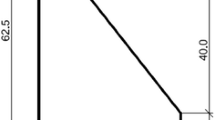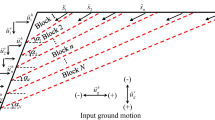Abstract
Traditional rigid body limit equilibrium method (RBLEM) was adopted for the stability evaluation and analysis of rock slope under earthquake scenario. It is not able to provide the real stress distribution of the structure, while the strength reduction method relies on the arbitrary decision on the failure criteria. The dynamic limit equilibrium solution was proposed for the stability analysis of sliding block based on 3-D multi-grid method, by incorporating implicit stepping integration FEM. There are two independent meshes created in the analysis: One original 3-D FEM mesh is for the simulation of target structure and provides the stress time-history, while the other surface grid is for the simulation of sliding surface and could be selected and designed freely. As long as the stress time-history of the geotechnical structure under earthquake scenario is obtained based on 3-D nonlinear dynamic FEM analysis, the time-history of the force on sliding surface could be derived by projecting the stress time-history from 3-D FEM mesh to surface grid. After that, the safety factor time-history of the sliding block will be determined through applying limit equilibrium method. With those information in place, the structure’s aseismatic stability can be further studied. The above theory and method were also applied to the aseismatic stability analysis of Dagangshan arch dam’s right bank high slope and compared with the the result generated by Quasi-static method. The comparative analysis reveals that the method not only raises the FEM’s capability in accurate simulation of complicated geologic structure, but also increases the flexibility and comprehensiveness of limit equilibrium method. This method is reliable and recommended for further application in other real geotechnical engineering.
Similar content being viewed by others

References
JIBSON R W. Methods for assessing the stability of slopes during earthquakes: A retrospective [J]. Engineering Geology, 2011, 122(1): 43–50.
CALTABIANO S, CASCONE E, MAUGERI M. Static and seismic limit equilibrium analysis of sliding retaining walls under different surcharge conditions [J]. Soil Dynamics and Earthquake Engineering, 2012, 37: 38–55.
CHEN Zu-yu, WANG Xiao-gang, XING Yi-chuan, YANG Jian, JIA Zhi-xing, WANG Yu-jie. Rock slope stability analysis: Theory methods and programs [M]. Beijing: China Water Power Press, 2005. (in Chinese)
YANG X L, YIN J H. Slope stability analysis with nonlinear failure criterion [J]. Journal of Engineering Mechanics, 2004, 130(3): 267–273.
LENCHMAN J B, GRIFFITHS D V. Analysis of the progression of failure of the earth slopes by finite elements [C]// GRIFFITHS D V, FENTON G A, MARTIN T R, et al. Slope Stability 2000: Proceedings of Sessions of Geo-Denver 2000. Denver: American Society of Civil Engineers, 2000, 289: 250–265.
YANG Qiang, LENG Kuang-dai, CHANG Qiang, LIU Yao-ru. Failure mechanism and control of geotechnical structures [M]// Constitutive Modeling of Geomaterials. Springer Berlin Heidelberg, 2013: 63–87.
HUANG Mao-song, JIA Cang-qin. Strength reduction FEM in stability analysis of soil slopes subjected to transient unsaturated seepagee [J]. Computers and Geotechnics, 2009, 36(1): 93–101.
WEI W B, CHENG Y M, Li L. Three-dimensional slope failure analysis by the strength reduction and limit equilibrium methods [J]. Computers and Geotechnics, 2009, 36(1): 70–80.
FU Wen-xi, LIAO Yi. Non-linear shear strength reduction technique in slope stability calculation [J]. Computers and Geotechnics, 2010, 37(3): 288–298.
YANG Qiang, ZHU Lin, XUE Li-jun. Computational accuracy of stability analysis based on 3-D multi-grid method [J]. Rock and Soil Mechanics, 2008, 29(1): 94–100. (in Chinese)
LIU Yao-ru, YANG Qiang, Xue Li-jun, ZHOU Wei-yuan. Rock slop stability analysis with nonlinear finite element method [C]// CAI Mei-feng, WANG Jin-an. Boundaries of Rock Mechanics: Recent Advances and Challenges for the 21st Century. London: Taylor & Francis Group, 2008, 503–507.
NEWMARK N M. Effects of earthquake on dams and embankments [J]. Geotechnique, 1965, 15(20): 139–159.
RATHJE E M, ANTONAKOS G. A unified model for predicting earthquake-induced sliding displacements of rigid and flexible slopes [J]. Engineering Geology, 2011, 122(1): 51–60.
SAYGIL I G, RATHJE E M. Empirical predictive models for earthquake-induced sliding displacements of slopes [J]. Journal of Geotechnical and Geoenvironm ental Engineering, 2008, 134(6): 790–803.
ZHANG Bo-yan, CHEN Hou-qun. Analysis on abutment aseismatic stability by using finite element and rigid body limit equilibrium method [J]. Chinese Journal of Rock Mechanics and Engineering, 2001, 20(5): 665–670. (in Chinese)
LIU Hong-shuai, TANG Li-qiang, BO Jin-shan, LIU De-dong. New method for determining the seismic safety factor of a rock slope [J]. Journal of Harbin Engineering University, 2001, 20(5): 665–670. (in Chinese)
QIAN Jia-huan, YING Zong-ze. Theory and computation of soil engineering [M]. Beijing: China Waterpower Press, 1996: 318–327. (in Chinese)
HJIAJ M, FORTIN J, de SAXCE G. A complete stress update algorithm for the non-associated Drucker-Prager model including treatment of the apex [J]. International Journal of Engineering Science, 2003, 41(10): 1109–1143.
SCHREYER H L, KULAK R F, KRAMER J M. Accurate numerical solutions for elastoplastic models [J]. Journals of Pressure Vessel Technology, 1979, 101(2): 226–234.
CHEN Xin, YANG Qiang, HUANG Yan-song, CHEN Xin. Sub-incremental method for perfect elasto-plastic material based on D-P yield criteria [J]. Chinese Journal of Rock Mechanics and Engineering, 2002, 2: 2465–2469. (in Chinese)
ORTIZ M, POPOV E P. Accuracy and stability of integration algorithms for elastoplastic constitutive relations [J]. International Journal for Numerical Methods in Engineering, 1985, 21(9): 1561–1576.
LIU Jing-bo, DU Xiu-li. Structural dynamics [M]. Beijing: China Machine Press, 2005: 119–122.
LIU Jing-bo, DU Yi-xin, WANG Zhen-yu, WU Jun. 3D Viscous-spring artificial boundary in time domain [J]. Earthquake Engineering and Engineering Vibration, 2006, 5(1): 93–102.
LIU Jing-bo, DU Yi-xin, YAN Qiu-shi. Viscous-spring artificial boundary and earthquake wave input in the general finite element software [J]. Journal of Disaster Prevention and Mitigation Engineering, 2007, 27: 37–42. (in Chinese)
DEEKS A J, RANDOLPH M F. Axisymmetric time-domain transmitting boundaries [J]. Journal of Engineering Mechanics, 1994, 120(1): 25–42.
LYSMER J, KUHLEMEYER R L. Finite dynamic model for infinite media [J]. J Engng Mech Div ASCE, 1969, 95: 759–877.
GHARTI H N, KOMATITSCH D, OYE V, MARTIN R, TROMP J. Application of an elastoplastic spectral-element method to 3D slope stability analysis [J]. International Journal for Numerical Methods in Engineering, 2012, 91(1): 1–26.
WANG Yu, CAO Zi-jun, AU Siu-kui. Practical reliability analysis of slope stability by advanced Monte Carlo simulations in a spreadsheet [J]. Canadian Geotechnical Journal, 2010, 48(1): 162–172.
Author information
Authors and Affiliations
Corresponding author
Additional information
Foundation item: Project(2013-KY-2) supported by the State Key Laboratory of Hydroscience and Engineering of Hydroscience, China; Project(50925931) supported by the National Funds for Distinguished Young Scientists, China
Rights and permissions
About this article
Cite this article
Liu, Yr., He, Z., Leng, Kd. et al. Dynamic limit equilibrium analysis of sliding block for rock slope based on nonlinear FEM. J. Cent. South Univ. 20, 2263–2274 (2013). https://doi.org/10.1007/s11771-013-1733-2
Received:
Accepted:
Published:
Issue Date:
DOI: https://doi.org/10.1007/s11771-013-1733-2



